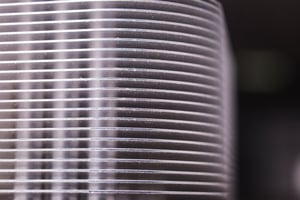Understanding MPR in Air Filtration: What is MPR in Air Filters?
In an era where the quality of the air we breathe has become an increasing concern, the role of air filters in maintaining healthy indoor environments cannot be overstated. Every breath we take contains a mixture of particles, allergens, and pollutants that can impact our well-being. It is the air filters, quietly at work within our heating, ventilation, and air conditioning (HVAC) systems, that shield us from the invisible threats that lurk in the very air we depend on.
But not all air filters are created equal. The efficiency and effectiveness of an air filter can vary significantly, and that's where the concept of MPR, or Microparticle Performance Rating, enters the scene. MPR is a vital factor in the world of air filtration, guiding us in our quest for cleaner, purer air indoors.
In this article, we will unravel the mysteries of MPR in air filtration, exploring what MPR is, how it differs from other rating systems, and why it matters. We will delve into the intricacies of MPR ratings, helping you understand what each rating signifies and how to choose the right MPR-rated air filter for your specific needs. By the end of this journey, you will be equipped with the knowledge to make informed decisions that can lead to a healthier, more breathable living space for you and your loved ones. Let's embark on this enlightening exploration of MPR in air filtration.
What is MPR?
MPR, or Microparticle Performance Rating, is a critical metric in the realm of air filtration. It serves as a standardized system for measuring the effectiveness of air filters in capturing and removing microparticles from the air. These microparticles include dust, pollen, pet dander, smoke, and other tiny airborne contaminants that can adversely affect indoor air quality and human health.
Defining MPR and Its Purpose
The primary purpose of MPR is to provide consumers with a clear and reliable method for evaluating the performance of air filters. Without such a rating system, selecting the right air filter for specific needs could be a daunting task, as there is a wide variety of filters available on the market, each claiming various degrees of filtration efficiency.
How MPR Measures Air Filter Effectiveness
MPR assesses air filter effectiveness by focusing on the filtration of microparticles, which are particles with diameters as small as 0.3 microns. These minuscule particles are often the most challenging to capture and can penetrate deep into the respiratory system when inhaled. MPR ratings are typically represented as numbers, and a higher MPR value indicates a more efficient air filter in trapping these tiny particles.
Air filter manufacturers use specialized testing procedures to determine an air filter's MPR rating. These tests involve exposing the filter to a controlled airflow containing microparticles of varying sizes. The filter's ability to capture and retain these particles is then quantified, and the MPR rating is assigned accordingly.
Organizations and Standards Using MPR for Rating Air Filters
One of the most notable organizations that uses MPR for rating air filters is 3M, a prominent manufacturer of filtration products. 3M introduced the MPR rating system to provide consumers with a more precise and consumer-friendly way to understand air filter efficiency.
While MPR is primarily associated with 3M filters, other manufacturers may adopt similar rating systems or adhere to recognized standards such as MERV (Minimum Efficiency Reporting Value). MERV is a widely accepted industry standard that rates air filters based on their ability to capture particles of different sizes. It's essential to be aware of these various rating systems and standards to make informed decisions when selecting air filters that best suit your specific indoor air quality requirements.
Understanding MPR and its significance allows consumers to make educated choices when it comes to air filtration, contributing to a healthier and more comfortable living environment.
How MPR Differs from Other Rating Systems
While MPR (Microparticle Performance Rating) is a valuable metric for evaluating air filters, it's important to understand how it differs from other common rating systems like MERV (Minimum Efficiency Reporting Value). Each rating system has its unique characteristics, strengths, and limitations.
Comparing MPR to MERV
- Particle Size Focus:
- MPR: MPR primarily focuses on the filtration of microparticles, including those as small as 0.3 microns. It provides a more detailed assessment of a filter's ability to capture these tiny contaminants.
- MERV: MERV, on the other hand, rates filters based on their performance across a range of particle sizes, including larger particles. It provides a broader view of a filter's efficiency but may not specifically address very fine microparticles.
- Granularity of Ratings:
- MPR: MPR ratings are often more granular, with a wider range of values (e.g., MPR 100 to MPR 2800). This allows consumers to choose filters with specific filtration capabilities tailored to their needs.
- MERV: MERV ratings are generally categorized into broad ranges (e.g., MERV 1-20), which can make it more challenging for consumers to differentiate between filters within a given MERV category.
- Ease of Understanding:
- MPR: MPR ratings are designed to be consumer-friendly and easier to understand. Higher MPR values indicate higher filtration efficiency, which can help consumers quickly identify better-performing filters.
- MERV: MERV ratings may be less intuitive for consumers, as the numeric values do not directly correlate with filtration efficiency. A MERV 8 filter, for example, may not necessarily outperform a MERV 11 filter in capturing microparticles.
Advantages of MPR in Evaluating Air Filters
- Specificity: MPR provides a specific and detailed assessment of a filter's ability to capture microparticles, which are often the most harmful to indoor air quality and health.
- Consumer-Friendly: MPR ratings are designed to be consumer-friendly, making it easier for individuals to choose filters that match their air quality needs.
- Precision: MPR offers a more precise representation of filtration efficiency for microparticles, allowing consumers to make more informed decisions.
Limitations of MPR in Evaluating Air Filters
- Narrow Focus: MPR's primary focus on microparticles may not address larger particles or certain contaminants effectively.
- Brand-Specific: MPR is associated with 3M filters, which means that not all air filter manufacturers use this rating system. This can limit options when choosing filters.
- Lack of Industry Standardization: MPR is not an industry-wide standard, unlike MERV. Therefore, it may not be as universally recognized or regulated.
Understanding MPR Ratings
MPR (Microparticle Performance Rating) is a valuable tool for gauging the effectiveness of air filters in capturing microparticles from the air. MPR ratings offer consumers a clear indication of an air filter's filtration efficiency. To fully grasp MPR ratings, let's delve into the range of ratings and what each signifies in terms of filtration efficiency:
MPR Rating Range:
MPR ratings typically span a range of values, with higher numbers indicating greater filtration efficiency. The specific range may vary slightly among manufacturers, but it commonly falls within the following scale:
- MPR 100-300: Filters in this range are typically designed for basic dust and pollen filtration. They can capture larger particles but may not be as effective against finer microparticles or allergens.
- MPR 400-1000: Filters within this range offer improved filtration of smaller microparticles, making them suitable for capturing common allergens like pet dander and mold spores.
- MPR 1100-1500: Filters in this range are designed to provide enhanced filtration, capable of trapping even finer microparticles, including smoke and smog particles.
- MPR 1900-2200: Filters in this category excel at capturing extremely small particles, such as bacteria and particles from wildfire smoke. They significantly improve indoor air quality.
- MPR 2500-2800: Filters with MPR ratings in this highest range offer top-tier filtration performance, effectively removing even the tiniest microparticles, including viruses, from the air.
Examples of Common MPR Ratings and Their Significance:
- MPR 300: A filter with an MPR of 300 is suitable for basic particle removal. It can capture larger particles like dust and pet hair, making it an excellent choice for maintaining a cleaner living space.
- MPR 1000: This rating indicates an air filter with enhanced filtration capabilities. It can capture smaller microparticles, including pollen and common allergens, making it beneficial for allergy sufferers.
- MPR 1500: Filters with this rating are well-equipped to tackle finer microparticles, such as smoke and mold spores. They are particularly useful in areas with air quality concerns, like regions prone to wildfires.
- MPR 2200: An MPR 2200-rated filter offers advanced filtration, suitable for removing bacteria and even some viruses from the air. It provides superior indoor air quality for health-conscious households.
- MPR 2800: Filters with an MPR of 2800 are at the top of the range, capable of capturing nearly all microparticles, including the smallest viruses. These filters are ideal for environments where pristine air quality is paramount, such as hospitals or homes of individuals with severe respiratory conditions.
Understanding MPR ratings empowers you to choose the right air filter to address your specific air quality needs, ensuring a healthier and more comfortable indoor environment.
Factors to Consider When Choosing an MPR-Rated Air Filter
Selecting the right air filter with a specific MPR (Microparticle Performance Rating) is essential for maintaining clean indoor air. Several factors should be taken into account to ensure that the chosen filter aligns with your specific needs and circumstances:
- Microparticle Size and Filtration Needs:
- Consider the size of microparticles you want to target. Filters with higher MPR ratings excel at capturing smaller particles. If you're concerned about allergens or fine particulate matter, opt for a higher MPR filter.
- HVAC System Compatibility:
- Ensure that the selected MPR-rated filter is compatible with your HVAC system. Check the manufacturer's recommendations and specifications to confirm compatibility.
- Airflow and Pressure Drop:
- Different MPR-rated filters may have varying levels of airflow resistance, known as pressure drop. Filters with higher MPR ratings often have denser filter media, which can reduce airflow. If your HVAC system relies on strong airflow, consider filters that strike a balance between filtration efficiency and airflow performance.
- Filter Size and Dimensions:
- Measure the dimensions of your existing filter slot or filter holder. Choose an MPR-rated filter that fits snugly and securely within your HVAC system. Filters that don't fit correctly can allow unfiltered air to bypass the filter.
- Indoor Air Quality Concerns:
- Assess your indoor air quality concerns. If you live in an area prone to wildfires, smoke, or high pollen levels, opt for a filter with a higher MPR rating to address these specific challenges.
- Allergy and Health Considerations:
- If you or your family members have allergies, asthma, or respiratory conditions, select an MPR-rated filter that targets allergens and fine particles effectively. Filters rated MPR 1000 or higher are often recommended for allergy relief.
- Frequency of Filter Replacement:
- Consider your willingness and ability to perform regular filter maintenance. Filters with higher MPR ratings may require more frequent replacement because they capture more particles, which can lead to faster clogging.
- Budgetary Constraints:
- Evaluate your budget for air filter maintenance. Higher MPR-rated filters generally offer superior filtration but can be more expensive. Weigh the cost against the benefits and the frequency of replacement to make an informed decision.
- Environmental Impact:
- Some filters, especially those with very high MPR ratings, may be less environmentally friendly due to their increased density and disposal requirements. Consider eco-friendly alternatives if sustainability is a priority.
- Manufacturer and Brand Reputation:
- Research the reputation of the filter manufacturer and the specific product you intend to purchase. Reputable brands often provide more reliable performance and product information.
- Personal Preferences:
- Lastly, factor in your personal preferences. Some individuals prioritize air quality above all else and may be willing to invest in the highest MPR-rated filters. Others may opt for a more budget-friendly option that meets their basic filtration needs.
By considering these factors, you can make an informed decision when selecting an MPR-rated air filter that aligns with your HVAC system, air quality concerns, and personal preferences. Choosing the right filter ensures that you and your loved ones breathe cleaner, healthier air within your home.
Conclusion:
In our journey to understand MPR (Microparticle Performance Rating) in air filtration, we've uncovered the critical role this rating system plays in maintaining indoor air quality and promoting better health. We've explored how MPR differs from other rating systems, its advantages and limitations, and the factors to consider when choosing an MPR-rated air filter.
As we conclude this exploration, it's evident that MPR provides consumers with a valuable tool to make informed decisions about air filters. By aligning the MPR rating with your specific filtration needs, HVAC system compatibility, and personal health considerations, you can significantly improve the quality of the air you breathe indoors.
Remember that air filtration is not a one-size-fits-all solution. Your choice of an MPR-rated filter should be a deliberate one, tailored to your unique circumstances and priorities. Whether you seek relief from allergies, protection from fine particles and pollutants, or simply a cleaner indoor environment, MPR empowers you to select the filter that suits your requirements.
In the pursuit of healthier living spaces and improved indoor air quality, the knowledge gained about MPR and its significance equips you to make choices that matter. Clean air is essential to our well-being, and with the right MPR-rated air filter, you can breathe easier, live healthier, and enjoy the comfort of a home environment that truly supports your health and happiness.


































.jpg)


.jpg?height=200&name=gifts-with-golden-stars-and-globes-for-christmas%20(1).jpg)
